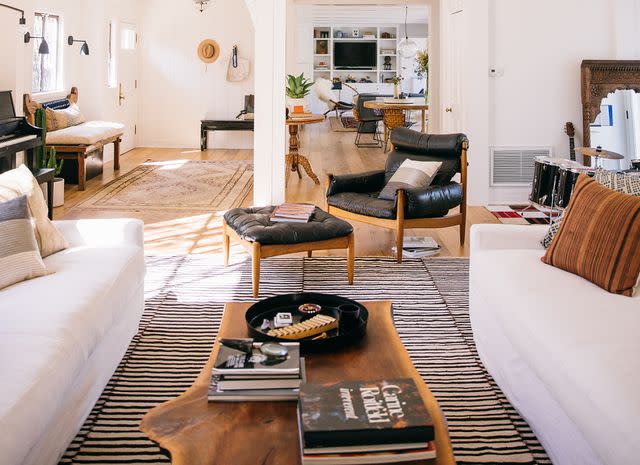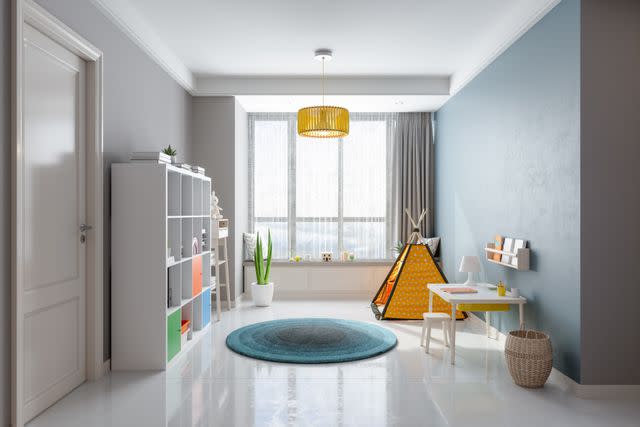10 Home Renovation Trends That Are on Their Way Out, According to Designers
If a home renovation is on the horizon for you, take note of these trends pros say you should skip.
Deciding to embark on a home renovation is an important and often expensive decision, but one that many homeowners decide to make. In fact, between 2019 and 2021, spending on home improvement and renovation soared, according to a 2023 report by the Joint Centers for Housing Studies at Harvard.
Your renovation choices will be yours to live with for years unless you move or undergo another remodel. Renovation trends come and go, and while it might be tempting to renovate your home with the latest, trendy look, you might want to think twice about these trends that several pros say are worth retiring as we move into 2024.
Related: How to Start Planning a Home Renovation

Wind & Bradford
Kitchens Without Upper Cabinets
Jessica Lynn Williams, founder and designer of Hendley & Co and RicRac, is hoping to leave this renovation trend in 2023, noting the design choice is "only for aesthetics." Leaving upper cabinets out of your kitchen renovation plans means giving up valuable storage space. If you're looking for something unique and functional, consider upper cabinets with a top hinge that creates easy access to small appliances or items you want to keep hidden from view.
Open Floor Plans
Open floor plans have retained their popularity throughout the years, with many new construction builds continuing to incorporate the plan into the initial architectural designs. But, the pendulum is beginning to swing back to spaces with a more defined structure. "The era of ubiquitous open floor plans and all-white interiors has transitioned," says Meredith Huck, owner and principal designer of House of Huck. "Today's homeowners seek more distinct and purposeful spaces, creating a shift towards well-defined areas that facilitate a seamless transition from the workday to leisure hours."

All-White Interiors and Kitchens
All-white countertops, flooring, cabinetry, and walls are becoming a thing of the past, say multiple designers. "While it is a personal favorite of mine as I love a clean and airy ambiance, I am receiving more requests from clients wishing to integrate a bit of color and texture into their homes," says Elizabeth Vergara, founder and lead designer of Vergara Homes.
"When we dominate a space with whites and creams it doesn't leave space for imagination and our creativity to thrive!" says Gabrielle Santiago, owner of Gabrielle Santiago Designs. Santiago predicts a shift from all whites and creams to bolder choices in tiles, paints, and more. "I predict we'll be seeing a lot of large-scale patterns on the floors and backsplashes of our kitchens and living rooms," she says. "I also am very excited that people are beginning to introduce natural elements into kitchen backsplashes and flooring, [such as] overgrouted/shmear grout stone and brick. I think we'll be seeing a lot more of this in the upcoming year."
"It’s now wood and natural textures," says Andrew Pharis with Vertical Arts Architecture. "Bold, and even black, is back. Statement countertop material like statement marble or something unique like wood or textured laminate add personality."
Minimalist Features
Often going hand-in-hand with an all-white interior, minimalist features are giving way to more texture, color, and depth. Think of installing a unique tile backsplash instead of a bare, smooth wall or choosing sophisticated finishing touches like elevated cabinet hardware instead of choosing cabinets without knobs or handles. "Everyone was so focused on wanting their spaces to feel clean and clutter-free [during the pandemic]," says Santiago. "However, this resulted in the design feeling lackluster and unrealistic for everyday function. I feel when we only focus on the minimal aspect and create a home with muted colors the home begins to feel sterile and uninviting."
Related: Both Minimalism and Maximalism Are Trending—Interior Designers Explain the Surprising Coexistence
Grey Flooring
"The grey trend seems to be slowing in many areas," says Matt Casey, director of Bona Certified Craftsman Program. "For single family flooring, there is a strong trend in neutral to lighter colors, with hardwoods remaining a popular option. This includes colors in the white, sand dune, birch, twig, and golden oak families."
Terrazzo
Terrazzo is by no means new—the "modern" era of its use as flooring dates back to 16th-century Italy—but its resurgence as a contemporary renovation choice has only become ubiquitous in the last five years or so. If you're unfamiliar with terrazzo, it is a composite material traditionally made from marble chips set in cement, but now includes materials like granite, quartz, or even glass mixed with a neutral-colored binder. Its influence has jumped from flooring to tile, countertops, and sinks, but Santiago thinks its popularity is about to fade. "Irregular flagstone and stone patterns in large scale will be the new terrazzo in more mid-century and modern-styled homes," she says.
Single-Use Spaces

Thinking ahead and creating spaces that are multi-functional instead of single-use is top of mind for many designers. "We've noticed the desire to occupy underutilized rooms or areas in the home more by introducing versatility," says Williams. "Our recent examples are including kitchen-like components (coffee maker, mini refrigerator, bar options) into a primary bedroom suite and finding a clever furnishing layout that allows one space to serve as a laundry room, playroom, and entertaining space."
"We're also seeing fewer spaces catered towards current day needs—for example, a designated playroom—and more spaces with multi-function purpose," says Huck. "A beautiful home office with a hidden Murphy bed that doubles as a guest room, or a formal dining room that can easily transition into an entertainer's dream complete with a bar space and cozy sitting area for friends and family. These spaces must be designed with careful intent so they can easily transition."
Farmhouse Style
The modern farmhouse look took the last decade by storm, and it was not uncommon to see homeowners renovating their homes to include features like shiplap, farmhouse sinks, and reclaimed, wide-plank wood floors. After saturating homes in this style for many years—and while many still love the look—it's time to retire this renovation trend, says Vergara. "The widely embraced farmhouse style, defined by rustic and vintage elements, is undergoing a shift as many designers are exploring a more novel style and diversity in their designs," she says.
Related: 16 Most Common Interior Design Styles, From Art Deco to Scandinavian
Renovating for Resale Value Only
Undergoing a major home renovation has often been seen as a way to help boost a home's value when the owners want to put it on the market. However, with the current market at a standstill and mortgage interest rates up, renovating for resale is taking a back seat to renovating for personal taste, according to Marvin's 2024 home renovation trend report. Resale value is still an important factor when it comes to making renovation choices, but more homeowners are now opting to renovate their homes for "emotional value, fulfillment, and comfort."
Ripping Out and Fully Replacing Flooring
In a more sustainable move, refinishing floors instead of full-on replacement is the way to go. "With the current economy, homeowners are looking for ways to update their homes without spending a lot of money," says Casey. To save money and be more eco-friendly, homeowners are considering refinishing hardwood floors rather than completely ripping them out and replacing them, he says.
"A report from IVL Swedish Environmental Research Institute and Bona showed that refinishing floors proved a carbon footprint reduction of 78 percent and significant cost savings compared to replacing flooring, while still providing a floor that feels brand new without the cost or environmental impact of new flooring."
Read the original article on Martha Stewart.

